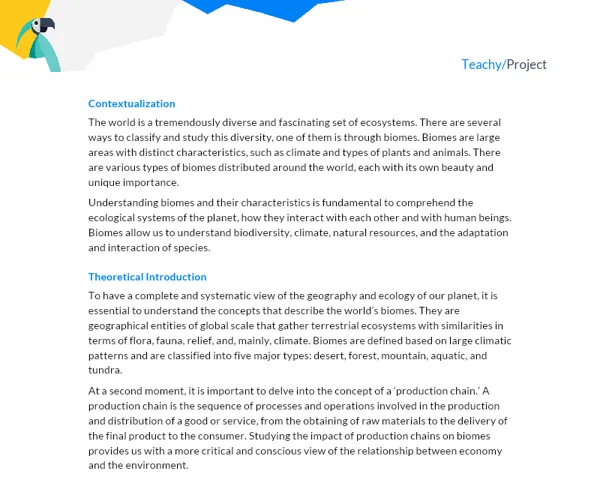Contextualization
Hello, kids! Let's embark on a journey to explore the relationships between the countryside and the city. Have you ever stopped to think about where the food we eat every day comes from? And how does it get to our table? These are some of the questions we will answer together on this adventure!
Firstly, we need to understand what the countryside and the city are. The countryside is the space where most of the food we eat is produced. It is where farmers plant and cultivate fruits, vegetables, grains, and many other foods that are part of our diet. The city, in turn, is where most of us live. It is the urban space, with streets, houses, buildings, and all the infrastructure that allows us to live comfortably.
But what does this have to do with Geography? Geography studies precisely the relationships between man and the space in which he lives. And the relationship between the countryside and the city is one of the most important. Without the countryside, the city would not have food to sustain itself. And without the city, the countryside would not have a market to sell its products. In other words, the countryside and the city need each other to exist.
Introduction
Now that we already know what the countryside and the city are and the importance of the relationship between them, let's delve a little deeper. Did you know that this relationship is linked to many other factors, besides the production and consumption of food? For example, the city needs the countryside to obtain clean water for the supply of its houses. And the countryside needs the city to provide labor and a market for its products.
Furthermore, the relationship between the countryside and the city is also linked to environmental issues. For example, when the city grows, it often means the destruction of green areas, which are important for climate regulation and biodiversity conservation. On the other hand, agricultural production can also have negative impacts on the environment, such as river pollution by pesticides.
Understanding these relationships is very important so that we can live more sustainably, that is, taking care of our planet and ensuring that future generations also have something to eat and somewhere to live. And that's why we are going on this discovery journey together! Let's go, kids, our adventure is just beginning!
Practical Activity
Title: "From Land to Table: Understanding the Journey of Food"
Project Objective
The project's objective is to allow students to understand and visualize the relationship between the countryside and the city, and the journey that food takes from its production in the countryside to the consumer's table. In addition, the activity will promote teamwork, time management, creativity, and the students' communication skills.
Project Description
The students will create a "Food Journey Map," which will be a visual representation of the path that a food item takes from the countryside to the city. They should identify the main points of this journey, such as the production site, transportation, market, and the consumer's home. Additionally, the students will have to write a short text explaining each stage of this journey and the importance of the countryside and the city in this process.
Required Materials
- Cardboard or poster board (for the map)
- Colored pens, colored pencils, crayons (for drawing and coloring)
- Magazines, newspapers, scissors, glue (for cutting and pasting images)
- Paper and pen (for writing the texts)
Step by Step
-
Divide the class into groups of 3 to 5 students. Each group will be responsible for a "Food Journey," that is, a specific food item that will be researched and mapped.
-
Each group should choose a food item to be the protagonist of their journey. It can be a fruit, a vegetable, a grain, or any other food that originates in the countryside and is consumed in the city.
-
The students should research the origin of the chosen food item, that is, where it is produced (countryside), how it reaches the city, and how it is consumed.
-
Based on the collected information, the students will create the "Food Journey Map." They should draw and/or paste images representing each stage of the journey. For example, if they choose the apple, the map can have drawings of the apple tree in the countryside, a truck transporting the apples to the city, a market where the apples are sold, and a home where the apples are consumed.
-
Next to each image, the students should write a short text explaining that stage of the journey. For example, in the case of the apple, they can write about how the apples are harvested in the countryside, how they are transported to the city, and how they are sold in the market.
-
Finally, the groups must present their "Food Journey Map" to the class. They should explain each stage of the journey and the importance of the countryside and the city in this process.
Delivery Format
Each group must deliver their "Food Journey Map" and perform a presentation for the class. I suggest that each group present their map in the form of a short play, where the students will represent the stages of the food journey. You can use creativity and make the presentation very fun!
Remember, the most important thing is to learn and have fun together on this journey! I am very excited to see what you will create!

